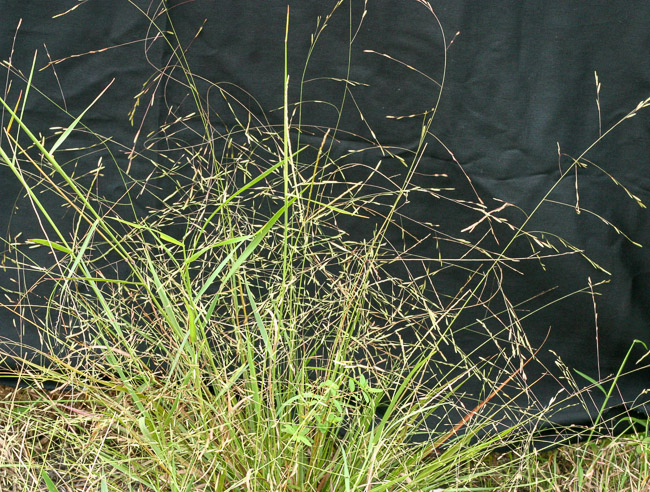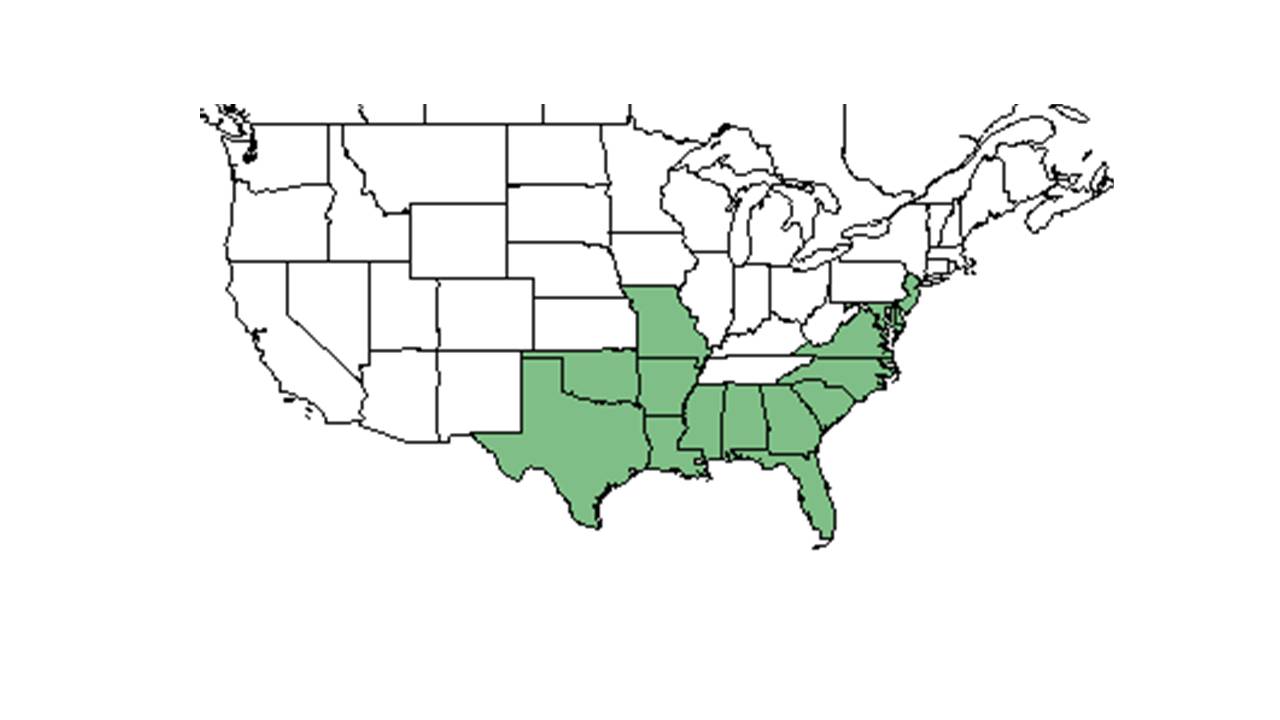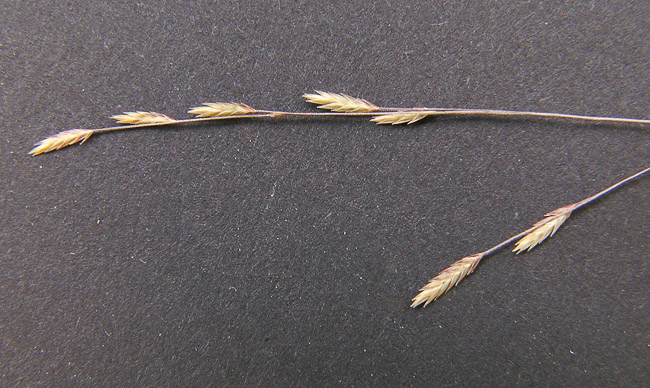Difference between revisions of "Eragrostis refracta"
KatieMccoy (talk | contribs) (→Distribution) |
(→Photo Gallery) |
||
| (49 intermediate revisions by 10 users not shown) | |||
| Line 3: | Line 3: | ||
{{taxobox | {{taxobox | ||
| name = Eragrostis refracta | | name = Eragrostis refracta | ||
| − | | image = | + | | image = Erag_refr.jpg |
| − | | image_caption = | + | | image_caption = Photo and permission granted by George Rogers and John Bradford, [http://floridagrasses.org/Index.html Florida Grasses.org] |
| regnum = Plantae | | regnum = Plantae | ||
| divisio = Magnoliophyta - Flowering plants | | divisio = Magnoliophyta - Flowering plants | ||
| classis = Liliopsida – Monocotyledons | | classis = Liliopsida – Monocotyledons | ||
| − | | ordo = | + | | ordo = Poales |
| familia = Poaceae ⁄ Gramineae | | familia = Poaceae ⁄ Gramineae | ||
| genus = ''Eragrostis'' | | genus = ''Eragrostis'' | ||
| Line 18: | Line 18: | ||
}} | }} | ||
| − | Common name: | + | Common name: coastal lovegrass |
==Taxonomic notes== | ==Taxonomic notes== | ||
| − | + | Synonyms: ''Eragrostis virginica'' (Zuccagni) Steudel (misapplied)<ref name=weakley>Weakley, A.S. 2020. Flora of the Southeastern United States. Edition of 20 October 2020. University of North Carolina at Chapel Hill, Chapel Hill, North Carolina.</ref> | |
| + | |||
| + | Varieties: none<ref name=weakley/> | ||
| + | |||
==Description== | ==Description== | ||
<!-- Basic life history facts such as annual/perrenial, monoecious/dioecious, root morphology, seed type, etc. --> | <!-- Basic life history facts such as annual/perrenial, monoecious/dioecious, root morphology, seed type, etc. --> | ||
| − | Weakley states that some authors have taken up the older name ''E. virginica'', as a synonym for ''E. refracta'', but the application of synonymy is uncertain<ref name=weakley | + | Weakley states that some authors have taken up the older name ''E. virginica'', as a synonym for ''E. refracta'', but the application of synonymy is uncertain.<ref name=weakley/> |
| − | Generally, for the ''Eragrostis'' genus, they are "annuals or perennials from short rhizomes or hardened bases. Glumes similar, shorter than lowest lemma. Florets more than 2. Lemmas 3-nerved, paleas persistent, ciliate" | + | Generally, for the ''Eragrostis'' genus, they are "annuals or perennials from short rhizomes or hardened bases. Glumes similar, shorter than lowest lemma. Florets more than 2. Lemmas 3-nerved, paleas persistent, ciliate."<ref name=radford/> |
| − | Specifically, for ''Eragrostis refracta'' species, they are "cespitose perennial from hardened base; culms 3-10 dm tall, nodes and internodes glabrous. Leaves primarily low cauline; blades elongate, to 2.5 dm long, 1.5-4 mm wide, pilose above, glabrous beneath, margins scaberulous; sheaths glabrous; ligules membranous, 0.1-0.2 mm long, long trichomes in throat. Panicle loose, open ½-3/4 height of the plant, ½ to as broad as long; branches flexuous, scaberulous. Spikelets with dark margins and light centers, 4-22 flowered, lateral spikelets longer than pedicels, appressed, 8-13 mm long, 1.5-1.8 mm wide. Glumes 1-nerved, scabrous keeled, acuminate, 1st glume 0,8-1.3 mm long, 2nd glume 1.5-2 mm long; lemmas scabrous keeled, acuminate, 1.5-1.8 mm long; paleas 1-1.5 mm long. Grain reddish, oblong, 0.5-0.7 mm long." | + | Specifically, for ''Eragrostis refracta'' species, they are "cespitose perennial from hardened base; culms 3-10 dm tall, nodes and internodes glabrous. Leaves primarily low cauline; blades elongate, to 2.5 dm long, 1.5-4 mm wide, pilose above, glabrous beneath, margins scaberulous; sheaths glabrous; ligules membranous, 0.1-0.2 mm long, long trichomes in throat. Panicle loose, open ½-3/4 height of the plant, ½ to as broad as long; branches flexuous, scaberulous. Spikelets with dark margins and light centers, 4-22 flowered, lateral spikelets longer than pedicels, appressed, 8-13 mm long, 1.5-1.8 mm wide. Glumes 1-nerved, scabrous keeled, acuminate, 1st glume 0,8-1.3 mm long, 2nd glume 1.5-2 mm long; lemmas scabrous keeled, acuminate, 1.5-1.8 mm long; paleas 1-1.5 mm long. Grain reddish, oblong, 0.5-0.7 mm long."<ref name=radford>Radford, Albert E., Harry E. Ahles, and C. Ritchie Bell. Manual of the Vascular Flora of the Carolinas. 1964, 1968. The University of North Carolina Press. 66-71. Print.</ref> |
==Distribution== | ==Distribution== | ||
| − | It is distributed from Deleware south to Florida, and west to Texas<ref name=weakley/> | + | It is distributed from Deleware south to Florida, and west to Texas.<ref name=weakley/> |
==Ecology== | ==Ecology== | ||
===Habitat=== <!--Natural communities, human disturbed habitats, topography, hydrology, soils, light, fire regime requirements for removal of competition, etc.--> | ===Habitat=== <!--Natural communities, human disturbed habitats, topography, hydrology, soils, light, fire regime requirements for removal of competition, etc.--> | ||
| − | Is found in open longleaf pine woods, open woodlands<ref name=fsu>Florida State University Robert K. Godfrey Herbarium database. URL: http://herbarium.bio.fsu.edu. Last accessed: June 2014. Collectors: Loran C. Anderson, J. M. Kane, Cindi Stewart, - MacClendons, and Annie Schmidt. States and Counties: Florida: Gadsden, Jackson, Liberty, and Suwannee. Georgia: Thomas.</ref> and in pineland, savannas, bogs and seeds, and marshes<ref name=weakley/> | + | Is found in open longleaf pine woods, open woodlands.<ref name=fsu>Florida State University Robert K. Godfrey Herbarium database. URL: http://herbarium.bio.fsu.edu. Last accessed: June 2014. Collectors: Loran C. Anderson, J. M. Kane, Cindi Stewart, - MacClendons, and Annie Schmidt. States and Counties: Florida: Gadsden, Jackson, Liberty, and Suwannee. Georgia: Thomas.</ref> and in pineland, savannas, bogs and seeds, and marshes.<ref name=weakley/> Is also found along the roadside edges. Requires high light levels. Is associated with areas with dry sand or dry, loamy sand soil types.<ref name=fsu/> ''E. refracta'' can also be found in pine-palmetto communities.<ref name= "Hilman">Hilman, J. B. (1964). "Plants of the Caloosa Experimental Range " U.S. Forest Service Research Paper SE-12 </ref> It has also been observed in wet and mesic pine savannas, but not in dry pine savannas.<ref>Walker, J. and R. K. Peet (1983). "Composition and species diversity of pine-wiregrass savannas of the Green Swamp, North Carolina." Vegetatio 55: 163-179.</ref> As well, a study found this species to increase in frequency when disturbance, like clearcutting, was conducted in the community.<ref>Brockway, D. G. and C. E. Lewis (2003). "Influence of deer, cattle grazing and timber harvest on plant species diversity in a longleaf pine bluestem ecosystem." Forest Ecology and Management 175: 49-69.</ref> It is listed by the USDA Natural Resources Conservation Service as a facultative wetland species, where it most often occurs in wetland habitats, but can also occasionally be found in non-wetland habitats as well.<ref name= "USDA"/> |
| − | Associated species include Composites, legumes, and grasses | + | Associated species include Composites, legumes, and grasses, as well as ''Eriocaulon lineare'' and ''Lachnocaulon minus.''<ref name=fsu/> |
===Phenology=== <!--Timing off flowering, fruiting, seed dispersal, and environmental triggers. Cite PanFlora website if appropriate: http://www.gilnelson.com/PanFlora/ --> | ===Phenology=== <!--Timing off flowering, fruiting, seed dispersal, and environmental triggers. Cite PanFlora website if appropriate: http://www.gilnelson.com/PanFlora/ --> | ||
| − | + | Generally, ''E. refracta'' flowers from July until October.<ref name=weakley/> This species has been observed to flower and fruit from September to November.<ref name=fsu/> | |
| − | |||
<!--===Seed dispersal===--> | <!--===Seed dispersal===--> | ||
<!--===Seed bank and germination===--> | <!--===Seed bank and germination===--> | ||
| − | + | ||
| − | < | + | ===Fire ecology=== <!--Fire tolerance, fire dependence, adaptive fire responses--> |
| − | + | ''E. refracta'' is considered to be a "fire-follower", where it can be found in areas that are burned, and years since fire disturbance does not affect frequency of this species much.<ref>Lemon, P. C. (1949). "Successional responses of herbs in the longleaf-slash pine forest after fire." Ecology 30: 135-145.</ref> | |
| + | |||
| + | ===Pollination=== | ||
| + | This species pollinates by hydrophilly, where pollen is dispersed by waterflow in rivers and streams.<ref name= "Koch">Koch, S. D. (1978). "Notes on the genus Eragrostis (Gramineae) in the southeastern United States." Rhodora 80: 390-403.</ref> | ||
| + | |||
| + | ===Herbivory and toxicology=== | ||
| + | It is considered to have good foraging value.<ref name= "Hilman"/> Cattle can graze on ''Eragrostis refracta'' in the early spring and the species tends to increase in abundance under grazing.<ref name= "Forestland Grazing">Byrd, Nathan A. (1980). "Forestland Grazing: A Guide For Service Foresters In The South." U.S. Department of Agriculture.</ref> | ||
<!--===Diseases and parasites===--> | <!--===Diseases and parasites===--> | ||
| − | ==Conservation and | + | ==Conservation, cultivation, and restoration== |
| − | == | + | ''E. refracta'' is listed as threatened by the Maryland Department of Natural Resources, Natural Heritage Program.<ref name= "USDA">USDA, NRCS. (2016). The PLANTS Database (http://plants.usda.gov, 8 May 2019). National Plant Data Team, Greensboro, NC 27401-4901 USA.</ref> |
| + | |||
| + | ==Cultural use== | ||
==Photo Gallery== | ==Photo Gallery== | ||
<gallery widths=180px> | <gallery widths=180px> | ||
| − | < | + | File: Erag_refr_Seedhead-FloridaGrasses-Org-Bradford&Rogers.jpg | <center> Seedhead of ''Eragrostis refracta'' <p>Photo and permission granted by George Rogers and John Bradford, [http://floridagrasses.org/Index.html Florida Grasse</gallery> |
| − | |||
| − | |||
| − | |||
| − | |||
| − | |||
| − | + | ==References and Notes== | |
Latest revision as of 13:50, 26 May 2023
| Eragrostis refracta | |
|---|---|

| |
| Photo and permission granted by George Rogers and John Bradford, Florida Grasses.org | |
| Scientific classification | |
| Kingdom: | Plantae |
| Division: | Magnoliophyta - Flowering plants |
| Class: | Liliopsida – Monocotyledons |
| Order: | Poales |
| Family: | Poaceae ⁄ Gramineae |
| Genus: | Eragrostis |
| Species: | E. refracta |
| Binomial name | |
| Eragrostis refracta (Muhl.) Scribn. | |

| |
| Natural range of Eragrostis refracta from USDA NRCS Plants Database. | |
Common name: coastal lovegrass
Contents
Taxonomic notes
Synonyms: Eragrostis virginica (Zuccagni) Steudel (misapplied)[1]
Varieties: none[1]
Description
Weakley states that some authors have taken up the older name E. virginica, as a synonym for E. refracta, but the application of synonymy is uncertain.[1]
Generally, for the Eragrostis genus, they are "annuals or perennials from short rhizomes or hardened bases. Glumes similar, shorter than lowest lemma. Florets more than 2. Lemmas 3-nerved, paleas persistent, ciliate."[2]
Specifically, for Eragrostis refracta species, they are "cespitose perennial from hardened base; culms 3-10 dm tall, nodes and internodes glabrous. Leaves primarily low cauline; blades elongate, to 2.5 dm long, 1.5-4 mm wide, pilose above, glabrous beneath, margins scaberulous; sheaths glabrous; ligules membranous, 0.1-0.2 mm long, long trichomes in throat. Panicle loose, open ½-3/4 height of the plant, ½ to as broad as long; branches flexuous, scaberulous. Spikelets with dark margins and light centers, 4-22 flowered, lateral spikelets longer than pedicels, appressed, 8-13 mm long, 1.5-1.8 mm wide. Glumes 1-nerved, scabrous keeled, acuminate, 1st glume 0,8-1.3 mm long, 2nd glume 1.5-2 mm long; lemmas scabrous keeled, acuminate, 1.5-1.8 mm long; paleas 1-1.5 mm long. Grain reddish, oblong, 0.5-0.7 mm long."[2]
Distribution
It is distributed from Deleware south to Florida, and west to Texas.[1]
Ecology
Habitat
Is found in open longleaf pine woods, open woodlands.[3] and in pineland, savannas, bogs and seeds, and marshes.[1] Is also found along the roadside edges. Requires high light levels. Is associated with areas with dry sand or dry, loamy sand soil types.[3] E. refracta can also be found in pine-palmetto communities.[4] It has also been observed in wet and mesic pine savannas, but not in dry pine savannas.[5] As well, a study found this species to increase in frequency when disturbance, like clearcutting, was conducted in the community.[6] It is listed by the USDA Natural Resources Conservation Service as a facultative wetland species, where it most often occurs in wetland habitats, but can also occasionally be found in non-wetland habitats as well.[7]
Associated species include Composites, legumes, and grasses, as well as Eriocaulon lineare and Lachnocaulon minus.[3]
Phenology
Generally, E. refracta flowers from July until October.[1] This species has been observed to flower and fruit from September to November.[3]
Fire ecology
E. refracta is considered to be a "fire-follower", where it can be found in areas that are burned, and years since fire disturbance does not affect frequency of this species much.[8]
Pollination
This species pollinates by hydrophilly, where pollen is dispersed by waterflow in rivers and streams.[9]
Herbivory and toxicology
It is considered to have good foraging value.[4] Cattle can graze on Eragrostis refracta in the early spring and the species tends to increase in abundance under grazing.[10]
Conservation, cultivation, and restoration
E. refracta is listed as threatened by the Maryland Department of Natural Resources, Natural Heritage Program.[7]
Cultural use
Photo Gallery
Seedhead of Eragrostis refracta Photo and permission granted by George Rogers and John Bradford, [http://floridagrasses.org/Index.html Florida Grasse
References and Notes
- ↑ 1.0 1.1 1.2 1.3 1.4 1.5 Weakley, A.S. 2020. Flora of the Southeastern United States. Edition of 20 October 2020. University of North Carolina at Chapel Hill, Chapel Hill, North Carolina.
- ↑ 2.0 2.1 Radford, Albert E., Harry E. Ahles, and C. Ritchie Bell. Manual of the Vascular Flora of the Carolinas. 1964, 1968. The University of North Carolina Press. 66-71. Print.
- ↑ 3.0 3.1 3.2 3.3 Florida State University Robert K. Godfrey Herbarium database. URL: http://herbarium.bio.fsu.edu. Last accessed: June 2014. Collectors: Loran C. Anderson, J. M. Kane, Cindi Stewart, - MacClendons, and Annie Schmidt. States and Counties: Florida: Gadsden, Jackson, Liberty, and Suwannee. Georgia: Thomas.
- ↑ 4.0 4.1 Hilman, J. B. (1964). "Plants of the Caloosa Experimental Range " U.S. Forest Service Research Paper SE-12
- ↑ Walker, J. and R. K. Peet (1983). "Composition and species diversity of pine-wiregrass savannas of the Green Swamp, North Carolina." Vegetatio 55: 163-179.
- ↑ Brockway, D. G. and C. E. Lewis (2003). "Influence of deer, cattle grazing and timber harvest on plant species diversity in a longleaf pine bluestem ecosystem." Forest Ecology and Management 175: 49-69.
- ↑ 7.0 7.1 USDA, NRCS. (2016). The PLANTS Database (http://plants.usda.gov, 8 May 2019). National Plant Data Team, Greensboro, NC 27401-4901 USA.
- ↑ Lemon, P. C. (1949). "Successional responses of herbs in the longleaf-slash pine forest after fire." Ecology 30: 135-145.
- ↑ Koch, S. D. (1978). "Notes on the genus Eragrostis (Gramineae) in the southeastern United States." Rhodora 80: 390-403.
- ↑ Byrd, Nathan A. (1980). "Forestland Grazing: A Guide For Service Foresters In The South." U.S. Department of Agriculture.
